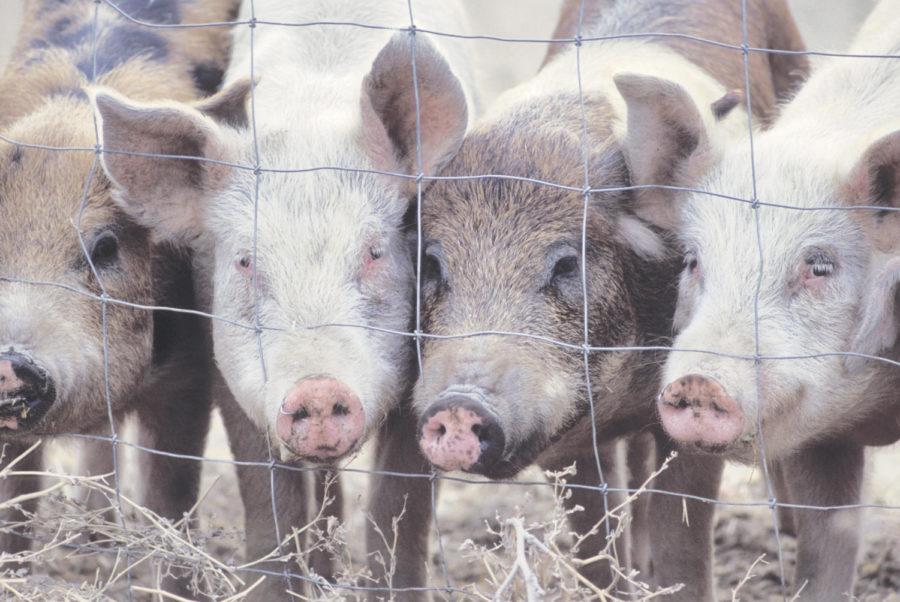Cline: McDonald’s phaseout could mean pricier pork
April 4, 2012
McDonald’s recently ignited a controversy in the food production industry by voting to phase out gestation crates and halting purchases from producers that use them. The gestation crate issue has long been a major debate in the pork industry, and with one of the nation’s biggest pork buyers refusing to use goods from gestation farms, it could greatly affect the practices of farmers and consumers.
Gestation crates are individualized housing systems used on a large number of hog farms and allow farmers to provide each hog with specific attention. They help reduce fighting and injury among the animals, as well as offering customized feeding and watering programs. The primary alternative is group housing pens, an environment that faces issues with aggression and competition. Conversely, gestation facilities often must consider a wide range of comfort components, ranging from temperature and ventilation to proper rations and manure management.
Gestation crates became popular in the 1970s as the swine industry moved more toward large, specialized operations. Like other major industries, pork production became consolidated and producers moved toward a greater numbers of pigs on fewer facilities. Animals were moved indoors in an effort to more closely monitor their health. These changes gave farmers the ability to raise leaner, larger and more efficient hogs. A 2007 study showed that, in Iowa, 10 percent of the hog farms made up 54 percent of the inventory.
Iowa is far and away the nation’s top pork producer, and the United States as a whole ranks third globally in pork production, according to the United States Department of Agriculture. Pork consumption worldwide has climbed by more than 40 million metric tons in the past 15 years, making pork the most widely consumed meat in the world. The United States has answered the call as the world’s predominant exporter, with exports quintupling since the late 1990s.
The issue with gestation crates arises when these attempts at maximum environmental comfort in certain areas are overshadowed by the size limitations of the stall. The average size of a modern crate for a 250-pound sow is roughly 2 feet wide by 7 feet long. Additionally, the sows confined to these spaces spend most of their lives in these narrow quarters, unable to turn around.
According to the Huffington Post, the move by McDonald’s “requires pork suppliers to provide plans by May to phase out crates that tightly confine pregnant sows.” According to the National Pork Production Council, McDonald’s alone comprises 1 percent of the annual pork consumption. According to a 2009 report from NPD Group Crest, breakfast sandwiches were the most consumed fast-food pork products, a classic McDonald’s staple.
McDonald’s is not alone in its decision. As the wave tends to work in the fast-food business, most companies follow the leader, and competitors are again following the lead of the golden arches. Burger King, Wendy’s and Hardees have joined in the phaseout of purchasing pork from gestation crate farms.
Producers have jumped on board and many were implementing adaptations to group housing before the phaseout was declared. Smithfield Foods, the world’s largest pork producer, along with Hormel Foods have made plans to eliminate the use of crates by 2017. Cargill has been working diligently to employ group housing on its family of farms.
States such as Oregon, Florida, Arizona and California have gone as far as to ban gestation crates. European Union member nations have begun the process of outlawing the use of gestation crates by 2013. Like any issue, there are studies to support and refute both sides of the debate. According to thepigsite.com, a collection of studies has shown little variance in the health and production of pigs in gestation crates compared to group settings. Farrowing rates and birth weights were similar in both systems.
For farmers, the move away from gestation crates may be inevitable. With corporate and political pressures rising, all swine farmers may have to abandon the practice that has dominated the industry for nearly 40 years. The question becomes what will happen to the economy. Pig prices per hundredweight in 2011 were roughly $20 higher than the previous five-year average. By implementing new housing and altering the current setups, farmers will have to retrain employees to cover new labor costs. Additionally, some experts estimate that veterinary and health care bills could rise because hogs penned together tend to be aggressive and even fight.
All in all, the growing number of on-farm expenses could rise to levels that could put smaller producers out of business and further consolidate the industry. According to a USA Today article, Smithfield estimates that its conversion costs could reach upwards of $300 million.
Consumer interest in animal welfare is growing, but if we are willing to move away from the current production to methods perceived to be more animal-friendly, we must also be prepared to adopt the potential elevation in price for those goods. The conversion away from gestation crates would not be a cheap, overnight process and we, as consumers, would need to be prepared to chip in a few more cents for our beloved bacon.

















